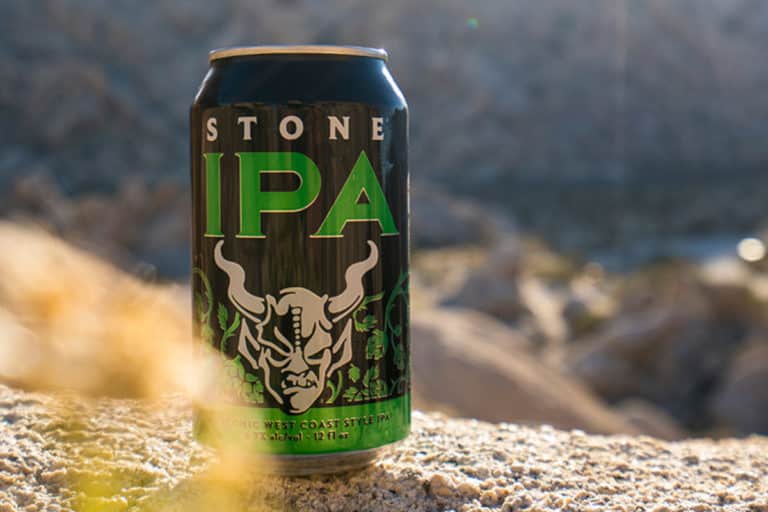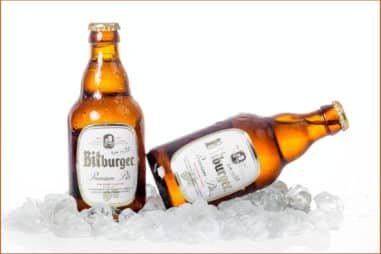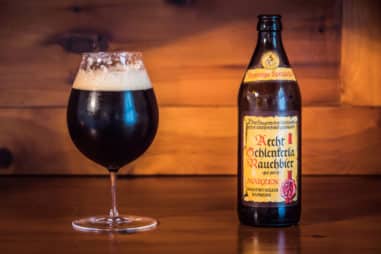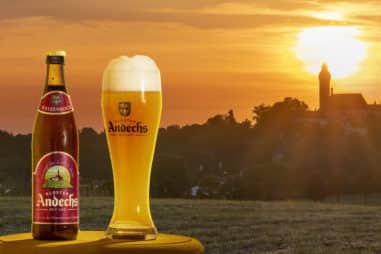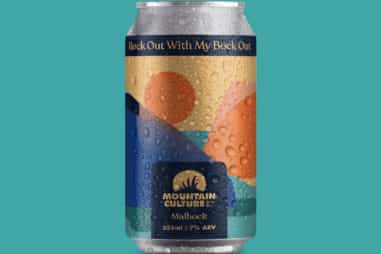Listen up beer drinkers. Before you start tossing beer slang terms in the pub like a proud beer snob, you have to know your IPAs. Not the trendy Hazy or Milkshake IPAs you see today. The classic American IPA.
Don’t worry. This won’t even take 10 minutes of your time. You could finish reading this before the IPA in your can hits halfway. Ready?
Is There an American IPA?
If American IPAs didn’t exist, then neither would any of those West or East Cost IPAs be sitting comfortably in your fridge.
You can think of American IPAs as the father of IPA substyles. West Coast and East Coast IPAs are like direct sons of an American IPA.
And then you have your Hazy IPA, Milkshake IPA, New England IPA, Juicy IPA, and so on, which also came from East Coast IPAs.
Yes – the IPA scene is vast. It would be weird to think that West Coast or East Coast IPAs came out of nowhere, right? There has to be a story. An origin story. Like how Bruce Wayne became Batman. Why Anakin became Darth Vader.
Those are all easy-peasy to explain, right? Well … the origin story of IPAs isn’t so bad either. In fact, before IPAs, it was just … Pale Ales.
Where Was the First American IPA Made?
You’ll have to go as far back as the 18th century. A time where Pale Ales were the only hoppy beer available.
As the story goes, these Pale Ales were to be exported to British troops in India. The problem was, a Pale Ale couldn’t survive the journey to India.
So what happened? Those Pale Ales were brewed with extra hops to preserve the flavor and aroma on its journey to India.
And there you have it! The English India Pale Ale was born! But wait – this is a story about American IPAs, so buckle up for a bit.
Word has it, the English IPA style was lost for some time. And then in the 1970s, proud and bold America took the style in and made some changes.
You can clearly guess what those changes were, right? Go on. You know you want to say it.
They made an American version of the English IPA by using American hop varieties. Soon after, the American IPA style exploded and spread throughout the United States.
What’s the Difference Between an English IPA and an American IPA?
The basic gist?
English IPAs came before American IPAs. So that sort of makes an English IPA the dad of an American IPA? But a father-son relationship isn’t going to tell you the important details.
What makes an English IPA different from an American IPA is the flavor. English IPAs aren’t intensely hoppy like American IPAs.
An English IPA has a more balanced malt and hop flavor. In addition, English IPAs will use English yeast strains that give these IPAs a fruity character.
If you took a sip from an English and American IPA, could you tell the difference? Well, here’s a question for you.
Could you tell the difference between coffee and tea? You would, right? And if you saw an English breakfast plate beside an American breakfast plate, you would know which one’s which, right?
Precisely.
English IPAs and American IPAs are different. And it’s a difference you can tell through taste, smell, and sight.
Generally, American IPAs have a more pronounced hop profile and stronger bitterness than English IPAs.
The Main Difference Lies in the Hop Variety
If someone were to ask you what the difference between an English IPA and American IPA is, what would your answer be?
You won’t exactly be able to give them a complete history lesson and talk to them about yeast strains. After all, written word is different from spoken word, wouldn’t you agree?
So, here’s what you’re going to say:
- American IPAs use American hop varieties that give a fruity, piney, and resinous flavor. Ultimately, American IPAs are more bitter than English IPAs.
- English IPAs use hop varieties that impart spicy, floral, and earthy flavor notes. Overall, an English IPA has more balance in maltiness, hoppiness, and bitterness.
Best Examples of an English IPA and American IPA
It’s not always enough to just explain differences through words. And that’s where taste comes in. The best way for you to truly tell the difference is by trying an English IPA and an American IPA.
Of course, not just any English or American IPA you can grab off any beer shelf. If you want a true American IPA, go for Stone Brewing Stone IPA.
And for a true English IPA, it’s none other than Guinness Nitro IPA.
What Makes an IPA an American IPA?
Simple.
An American IPA is all about hop flavor, bitterness, and aroma. Although some maltiness is present, it’s not the star of the show.
It’s the hop flavor, specifically, fruity, piney, resinous, and sometimes citrusy flavor notes. Another distinct quality of an American IPA is its bitterness.
On the IBU scale, an American IPA has an IBU rating between 50 to 70. IBU stands for International Bitterness Unit.
Basically, IBU tells you how bitter your beer is. The higher an IBU of a beer is, the more bitter it’s going to taste.
All beer will have an IBU rating between 5 and 120. Now, if an American IPA has an IBU between 50 to 70, it’s safe to say it’s quite bitter, right?
But what other qualities make an American IPA? That’s a great question. And this table should tell you everything you need to know (sourced from the Beer Style Guidelines of Brewers Association’s website):
| Qualities of an American IPA | Description |
| Flavor | Hop flavor ranges from high to very high. Fruity, piney, and resinous flavors. Some flavor notes also include citrus, tropical, stone fruit, sulfur, onion-garlic, floral, and catty. Malt flavor is medium-low to medium with a slight sweetness; toasty, biscuit, and caramel flavors may be present. Bitterness is also medium-high to very high. |
| Appearance | Pale to copper; some American IPAs will have a gold to orange-copper appearance. |
| Aroma | Similar to hop flavor: piney, floral, citrus, fruity, and resinous aromas. |
| Mouthfeel | Smooth medium body with moderate carbonation and a dry, clean finish. |
| Clarity | Clear but a slight haze is acceptable |
| ABV (Alcohol by volume) | 5.5% to 7.5% |
What Does American IPA Stand for?
American IPA stands for American India Pale Ale. Now, here’s an interesting question. Is an American IPA the same as an American Pale Ale?
Not at all. Both are hoppy in a way, but there’s still a difference. IPAs and APAs. How exactly do they differ then?
What Is the Difference Between an American Pale Ale and an American IPA?
The short answer? American IPAs have higher IBUs and ABVs than American Pale Ales (APA).
Put simply, an American IPA is more bitter and has more booze than an American Pale Ale. But if you’re looking for something deeper like the hops and maltiness, here’s the best way to describe it:
- An APA is well balanced in its hop and malt character, meaning neither hop nor malt overpowers the other
- An American IPA is hop-focused, so the malt is slightly restrained. For American IPAs, it’s really about letting the hops shine
Now if you were to order an American IPA, a well-made IPA shouldn’t make you say “Woah … this beer is well-balanced.” Instead, a well-made American IPA should make you say “Damn, these hops are delicious!”
Just remember. American IPA? Hop-focused. American Pale Ale? A balance between malts and hops.
Why Is It Called American IPA?
It’s called an American IPA because of the microbrewery revolution that happened during the 1980s in the U.S.
This so-called microbrewery revolution started with one man: Fritz Maytag. Back in 1965, Fritz Maytag owned 51% of a San Francisco brewery called Anchor Brewing. This brewery produced steam beer. It was a style that was popular during the Gold Rush. However, by the 1960s, steam beer was as extinct as dinosaurs.
Goodbye Anchor Brewing. Or so at least that’s what people thought. That Anchor Brewing had shut down. In fact, Anchor Brewing’s reputation at the time was that the beer it produced was bad.
Fritz Maytag sought to change the quality of the beer. Know how? He made a classic English Pale Ale, only this time he added two new parts:
- Fritz used American hops that had citrus-piney flavors
- He used a technique called dry hopping, which is adding hops to beer during or after fermentation. (During this time, dry hopping was nearly a forgotten brewing technique. You could say it was Fritz Maytag who resurrected the technique)
Adding American hops and resurrecting dry hopping gave birth to the first American Pale Ale: Liberty Ale.
Soon after, microbreweries followed suit and started brewing their own versions. Of course, this made microbreweries compete with one another to get noticed.
Who doesn’t love a little healthy competition, right?
This healthy sparring battle between microbreweries eventually led to adding more hops to APAs. In addition, these APAs had higher alcohol content than the original style.
Both the higher alcohol content and higher hop additions are what gave birth to the American IPA.
What Is the Difference Between American IPA and Regular IPA?
The difference? What difference? These IPAs are practically the same.
No wait – here’s a better explanation. A Regular IPA is simply what comes to mind when you think of an IPA.
Regular IPA isn’t a style. It was simply used as a loose term to differentiate itself from an English IPA. To tell you the truth, that’s all there is to it.
Don’t overthink it.
How to Brew American IPA
Here’s what’s so interesting about brewing an American IPA. It’s the best way to get your feet wet in homebrewing.
It’s the best style to homebrew so you can learn more about hop varieties, water chemistry, mashing temps, and so on.
Is it easy? Well … it’s 50/50. Some parts are quite easier to figure out, while other parts require patience and trial & error.
So how do you brew an American IPA? First, start with the hops.
What Hops Are Used in American IPA?
In American IPAs, hops take the front seat. Loud and proud. So, show off those hops by choosing American hop varieties. Some great options include the following:
- Simcoe
- Columbus
- Chinook
- Willamette
- Cascade
- Centennial
These are all great beginner hops to use for brewing an American IPA the first time. However, there are a ton of American hop varieties available today like Azaca, Citra, CTZ, Comet, El Dorado, Idaho 7, and more.
But as a first-time homebrewer, keep it simple. For now. Once you’ve gotten the hang of it, feel free to go wild with different American hop varieties.
Simcoe and Chinook are great bittering hops to use in the kettle boil. Personally, go with Chinook to add that nice bitter flavor to your American IPA.
For every 5 gallons (19 L) of beer, add 1 to 2 ounces (28 g to 57 g) of bittering hops. Then, 20 minutes before the boil ends, you can add another 1 to 2 ounces of hops. And finally, 5 minutes before the boil ends, you can add a couple more for a powerful hop flavor and aroma.
Here’s what that might look like for a 60-minute kettle boil:
- Add 0.5 ounces (14 g) of Chinook at the start of the boil
- Add 1 ounce (28 g) of Simcoe 20 minutes before the boil ends for a citrusy character
- Add 1 ounce (28 g) of Amarillo 5 minutes before the boil ends
Finally, don’t forget to pay attention to your mash temperature too. A mash temp between 153°F (67.22°C) to 155°F (68.33°C) should be good.
Dry Hopping Schedule
This depends on whether you plan to bottle your IPA or keg it.
After primary fermentation ends and you’ve successfully transferred it to your secondary fermenter, let your beer sit for 3 to 4 days. Then, add your dry hops and let the beer sit for another 3 to 4 days. Afterward, bottle it.
If you’re kegging your beer, the schedule will vary. Let your beer sit in your secondary fermenter for 7 to 10 days. Afterward, keg your beer and add your dry hops.
What Grains/Malt Are Used in American IPA?
For your grains, keep it simple too.
Remember, you’re not trying to make a world-class American IPA. The goal is to learn the fundamentals of homebrewing an American IPA.
For your base malt, go with 2-Row Malt. You can’t go wrong with 2-Row when brewing an American IPA. Alternatively, Pale Malt works well too.
For some complexity, you can add up to 20% Munich malt. Vienna malt also works well with American IPAs. In addition, using Munich malt should help boost the malt character. Adding crystal malt is fine too, but it shouldn’t exceed 5%.
Take note, though. You don’t want to boost the malt character in your American IPA too much. Biscuit malts sound appealing, but it’s not what makes a great American IPA.
Too much malt and you’re already heading towards English IPA territory. A basic grain bill could look like 10.5 lbs. (4.76 kg) of 2-Row Malt and 2.5 lbs. (1.13 kg) of Munich Malt.
Or, if you want to add crystal malts then add 10 lbs. (4.5 kg) of 2-Row Malt, 2 lbs. (0.91 kg) Munich, and 1 lb. (0.45 kg) Crystal 20 L.
What’s a Good Yeast Starter for Brewing an American IPA?
Since you’re making an American IPA, stick to American Ale yeast strains. A good starter yeast would be Safale US-05 as a dry yeast option.
If you prefer a liquid yeast option, Wyeast 1056 is a good option. Just be sure to use a yeast starter. For the fermentation temperature of your yeast, this will usually be provided on the label.
Generally, a good fermentation range for American yeast strains is between 63°F (17.22°C) to 68°F (20°C). However, read the label always just to be sure.
How Long Should Fermentation Take for an American IPA?
After you pitch your yeast, first make sure the fermentation temperature you set is 68°F (20°C). This will serve as the primary fermentation stage and should take about 1 week.
What Water Profile Should I Use for an American IPA?
Homebrewing 101: Don’t just use tap water and wing it.
Haven’t you ever wondered why water is one of the key ingredients in beer? Take this to heart. Even if you do every single part right but screw up your water profile, you’ll never nail down the style.
One thing to take note of is your chloride to sulfate ratio. Higher chloride levels and lower sulfate levels yield fruitier, juicier IPAs.
Lower chloride levels and higher sulfate levels yield more piney, bitter IPAs. Next, don’t forget your other minerals:
- Calcium: promotes yeast health and lowers pH
- Sodium: mainly for accentuating your beer’s flavor
- Magnesium: Also promotes yeast health
That just leaves your tap water. It’s better to use Reverse Osmosis (RO) water, carbon-filtered, or distilled water.
Buy a home test kit to test your water supply. Don’t worry, they’re readily available and easy to find. If there’s chloramine or chlorine present, you’ll need to treat it with a Campden tablet.
A good water profile as a starting point for an American IPA would be:
- Sulfates: 150 ppm
- Chloride: 55 ppm
- Magnesium: 5 ppm
- Calcium: 80 ppm
- Sodium: 10 ppm
Although this is a basic sample of what a good water profile would be for an American IPA, it’s not the only option.
You can use brewing software like Bru’n Water to help you determine what the right mineral profile is for a specific style.
Ultimately, you should aim for a mash pH between 5.2 to 5.4.
If your pH levels are too low, add calcium chloride to increase your pH level. If it’s too high, decrease it by adding lactic acid. For every 5 gallons (19 L) of beer, adding 1.5 teaspoons (6 g) should suffice.
Who Brews Harper’s American IPA?
A lot of the data you might find online about Harper’s American IPA can be confusing. Some sources will say Aldi Stores Ltd. manufactured it while others say it was brewed by Marston’s Brewery.
That’s not entirely true.
The label on the bottle reads “Harper’s Brewing Co. American IPA.” However, Harper’s Brewing Co. American IPA was brewed by Marston’s Brewery.
For those of you who didn’t know, Marston’s Brewery is a British pub, hotel operator, and brewery in the UK. It was previously known as Wolverhampton and Dudley Breweries plc until it was rebranded as Marston’s in 2007.
Now, Harper’s Brewing Co. American IPA was brewed by Marston’s Brewery specifically for Aldi Stores. However, Marston’s Brewery uses the brand name Harper’s Brewing Co in the packaging.
Who Makes Aldi American IPA?
That depends. Which IPA are you referring to?
Here’s what you need to understand about Aldi first.
It’s a discount grocery chain with nearly 1,500 locations in 32 states. Aldi is like the Trader Joe’s of Germany, but better.
Better how? For one, employees roam around the store to assist customers and even provide samples.
You get a lot of limited selection items in Aldi, including its beer. Now, this is important. All the beer sold in Aldi is Aldi’s in-house brand.
That means Aldi doesn’t sell beer unless it’s made by them. But not literally by them. Aldi doesn’t have any brewers or breweries. So, who makes it then?
Other breweries.
It’s simple. Aldi partners with several breweries around the world so they can produce beer you can get exclusively at Aldi.
So, if you want a beer made by Aldi, don’t drive to Walmart or Costco. Head to Aldi.
But what about Aldi’s American IPA? One of their American IPAs is brewed by Marston’s Brewery. However, they also have several IPA styles available, such as:
- Wild Range IPA made by Wild Range Brewing Company
- Anti Establishment IPA made by Anti Establishment Brewing Company
- BrewDog Punk IPA made by BrewDog Brewery
- Stateside IPA made by The Buckhorn Brewery
- Hazy IPA made by Stewart Brewing
- Grapefruit Infused IPA made by Memphis Blvd
- Proper Job IPA made by St Austell Brewery
- Joker IPA made by Williams Bros Brewing Co.
Aldi also doesn’t just sell IPAs. They also sell lagers, wheat beer, German lagers, Pale Ales, Pilsners, and more.
Is Shipyard American IPA Vegan?
Shipyard American IPA is not vegan, unfortunately. However, that doesn’t mean Shipyard Brewing Co. doesn’t have vegan options.
In October 2020, Shipyard Brewing Co. announced all the beer they produce and distribute in the U.S. is vegan-friendly.
However, their beer in the U.K. is not. Even if the ingredients are all vegan-friendly, they use small amounts of isinglass (fish guts) in their filtration process.
Is an American IPA the Same as a West Coast IPA?
West Coast IPAs are similar to American IPAs in a way, but they’re not exactly the same style. West Coast IPAs came after American IPAs, meaning it’s a substyle of an American IPA.
How are they different? West Coast IPAs are aggressively hopped, almost double the hops in a regular American IPA.
That means West Coast IPAs are even more bitter than American IPAs. But if you’re talking about hoppiness, both American and West Coast IPAs share that same quality.
Hops take the spotlight in both of these styles, but the amount of hops used in each style is different. In addition, West Coast IPAs will likely have a higher ABV than an American IPA.
Is a New England IPA the Same as an American IPA?
That’s ridiculous.
Is a NEIPA the same as an American IPA? Not in this timeline. Although NEIPAs are somewhat related to American IPAs, a NEIPA is more closely related to East Coast IPAs.
What Is the Difference Between American IPA and New England IPA?
How do you tell the difference?
For starters, NEIPAs are distinctively juicy and fruity. Although both styles use American hop varieties, NEIPAs stay away from bittering hops.
Instead, a NEIPA will use more fruity and tropical hop varieties like Citra, Mosaic, or Galaxy. And then there’s the bitterness.
Ah, classic bitterness.
IPA bitterness.
NEIPAs don’t have the same bitterness as American IPAs. The bitterness in a NEIPA is faint, restrained, and sometimes almost as if it’s not even there.
Why? Because juiciness and tropical fruitiness takes the center stage in a NEIPA style. If you were served a NEIPA beside an American IPA, you would know exactly which is which.
But if you served a NEIPA right beside orange juice? You’d probably have to take a sip from both glasses to tell the difference.
That’s how distinctively different a NEIPA is from an American IPA. Its hazy bright orange to gold appearance sets it apart from the clear, pale appearance of an American IPA.
What Is the Difference Between an American IPA and an Imperial IPA?
It’s really quite simple.
If an American IPA is a hopped-up version of a Pale Ale, where does that leave an Imperial or Double IPA?
It’s a tuned-up version of an American IPA. Or in other words, tuned-up booze, hops, ABV, and bitterness.
That’s exactly it.
If you thought American IPAs had strong bitterness and high alcohol content, Imperial IPAs have nearly double that amount.
What Is the Difference Between a West Coast IPA and an East Coast IPA?
While West Coast IPAs are aggressively bitter, East Coast IPAs tune the bitterness down by adding sweet maltiness.
On either coast, you’ll find a massive amount of hops are used. And the hops are still the star of the show in both styles.
However, an East Coast IPA is softer on your palate. It’s polite, whereas a West Coast IPA is bold. For those who don’t enjoy the bitter finish of a West Coast IPA, East Coast IPAs should do the trick.
An East Coast IPA is fruity and tropical, has less perceived bitterness, and has a clean, sweet malty character. It’s definitely easier to drink.
However, if you were to ask which is better. There isn’t a clear winner here. West Coast styles aren’t better than East Coast styles or vice versa.
What Is the Difference Between a West Coast IPA and a New England IPA?
Think of it this way.
The difference between a West Coast and East Coast IPA is like the distance between Venus and Earth. But a New England IPA and a West Coast IPA? That’s going as far as Mars.
Point is, the differences between a West Coast IPA and New England IPA are even wider. NEIPAs have lower bitterness than East Coast IPAs.
NEIPAs are also intensely juicy and fruity. Compare that to a West Coast IPA and these styles live in separate IPA scales.
Finally, the appearance. NEIPAs are hazy AF. West Coast IPAs are well … clear.
Is Hazy IPA East Coast or West Coast?
A Hazy IPA takes inspiration from East Coast IPAs. Some refer to New England IPAs (NEIPAs) as Hazy IPAs.
Hazy IPAs still use a generous amount of hops, but it’s the hazy, opaque appearance that makes it stand as its own style.
What Is the Difference Between a Hazy IPA and a West Coast IPA?
It’s about the same as the difference between a West Coast IPA and a NEIPA.
Now, hold on for just a minute. Are you saying NEIPAs and Hazy IPAs are the same? Well, somewhat. But not entirely.
The biggest difference between a West Coast IPA and a Hazy IPA is the filtration process. Hazy IPAs are unfiltered to help bring about the haziness. West Coast IPAs are typically filtered for clearer beer.
In addition, the grain bill in a Hazy IPA is different from a West Coast IPA. Hazy IPAs require special adjuncts like flaked wheat and oats to boost the texture and body and create more haziness.
West Coast IPAs don’t focus too much on the malt, because as mentioned earlier, hops really shine in a West Coast IPA.
Is a Hazy IPA the Same as a NEIPA?
Here’s where things can get a little confusing.
Hazy IPAs are a term that is used interchangeably with NEIPAs. It’s somewhat a marketing strategy for breweries to make the most of this NEIPA craze.
Technically, they might seem the same because people use the terms interchangeably so often. But there is a thin line between the two.
What Is the Difference Between Hazy IPA and NEIPA?
Put it this way. The bare-bones definition of a Hazy IPA is that it’s an unfiltered IPA. The “Hazy” term mostly refers to the character or appearance of an IPA.
NEIPAs, on the other hand, are intensely fruity and tropical. A NEIPA also has juicy qualities and a hazy appearance. Not to mention, the body of a NEIPA is softer and fuller.
It’s safe to say that all NEIPAs are Hazy IPAs, but not all Hazy IPAs are NEIPAs. You can have a Hazy IPA but with a dry and sharp finish.
Mostly, it seems like Hazy IPAs are more of a marketing term tossed around because of the haze craze going on.
You’ll find a lot of breweries releasing Lagers, Pilsners, and even Barley Wine with the term “Hazy” in it. Hazy Lager. Hazy Pilsner. Hazy everything!
That pretty much covers it. If it’s not in the label, it’s going to be in their product descriptions. Something like “citrus and fruity with a hazy …”
Is Wicked Hazy the Same as New England IPA?
Samuel Adams Wicked Hazy is a New England IPA. On their site, they even say it’s a “Juicy New England IPA.”
Its tropical and fruity flavor notes include mango, peach, and pineapple.
Is Sam Adams New England IPA the Same as Wicked Hazy?
Why wouldn’t it be? Wicked Hazy is a catchy name given to Samuel Adams Brewery’s New England IPA. In fact, it’s not the only Hazy IPA Samuel Adams has.
They even have another catchy name for their light and hazy lager: Wicked Easy. And then there’s Just The Haze, which is a non-alcoholic, hazy, and juicy IPA.
Is a Hazy IPA the Same as a Juicy IPA?
Well, the Beer Style Guidelines of the Brewers Association seem to think Juicy and Hazy IPAs are the same.
However, there might be a slight difference between the two.
What Is the Difference Between a Juicy and Hazy IPA?
Juicy mostly refers to the flavor and aroma of beer. If it has juicy qualities or qualities similar to fruit juice, then it’s safe to describe it as juicy.
Hazy isn’t exactly juicy. Hazy is more of appearance. How it looks. What your eyes see. And not what you taste.
So, what does that mean? Put simply, not all Juicy IPAs are Hazy IPAs. You can have a Juicy IPA but the appearance is pale golden or clear.
With so many IPA styles booming, it’s very possible for this to happen. Also, take note. To get the juiciness in an IPA, you need certain hop varieties.
Tropical or stone fruit varieties, for example, impart juicy flavors and aromas in beer. With a Hazy IPA, it’s not so much about the hops.
Instead, it’s about the malt/grains, the yeast, and the filtration process. That means you can make a Juicy IPA without making it hazy.
And you can make a Hazy IPA without making it juicy either.
Is an Unfiltered IPA the Same as a Hazy IPA?
Yes and No.
Unfiltered IPAs are more of a broad category, and Hazy IPAs are simply part of that category. Unfiltered IPA/beer simply means the beer does not undergo extra filtration before bottling.
The result is a beer that’s less clear than a filtered IPA/beer.
Think of unfiltered as a process. It doesn’t fully contribute to the haziness of a Hazy IPA, but it does still have a role.
Furthermore, Hazy IPAs aren’t the only unfiltered IPAs you’ll see today. Other examples include:
- Milkshake IPAs
- New England IPAs
- Zwickel lagers
- Florida-style IPAs
- Glitter beers
- Kellerbier
- Gose
What Are the Best American IPAs Worth Trying?
As mentioned earlier, Stone Brewing’s Stone IPA is a must-try if you want a clear description of what an American IPA tastes like.
However, it’s not the only worthy American IPA worth trying these days. Ready to take a sip? Here are the best American IPAs worth trying:
| American IPAs | Brewery |
| Lagunitas IPA | Lagunitas Brewing Company |
| Susan American IPA | Hill Farmstead Brewery |
| Bell’s Two Hearted Ale | Bell’s Brewery |
| Union Jack | Firestone Walker Brewing Company |
| 60 Minute IPA | Dogfish Head Brewery |
| Julius | Tree House Brewing Company |
| Focal Banger | The Alchemist |
| Solstice IPA | 49th State Brewing Company |
| Pallet Jack IPA | Barley Brown’s Beer |
| Bank Hotel | Brasserie du Bas Canada |
| Axe Man | Surly Brewing Company |
| Nelson American IPA | Alpine Beer Company |
| TDH Alien Church | Tired Hands Brewing Company |
| Torpedo Extra IPA | Sierra Nevada Brewing Co. |
| Blind Pig IPA | Russian River Brewing Company |

